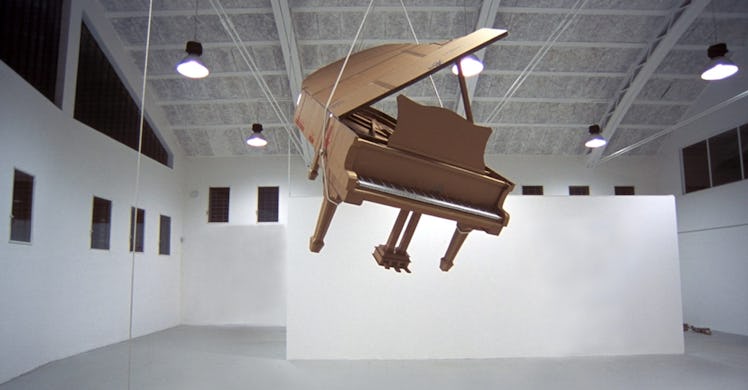How To Get Your Kids To Build Awesome Cardboard Creations
Thinking outside (and inside) the box.

You know how, when you buy a kid a present, they end up liking the box way more? There might be a reason for that. Turns out, cardboard is a fine sculptural medium, akin to snow and boogers. In fact, if you can manipulate it the way acclaimed modern artist Chris Gilmour does, you can recreate just about anything by using the box that it came in.
“I studied ‘Art in Social Context’”, says Gilmour. “It’s a course of study in fine arts based on public art, community art, art in schools, and hospitals. I found that traditional materials were very expensive, and you can work just as well with cardboard.” So, he decided to make cardboard his medium. Ever since, he’s built everything from a life-size FIAT 500 to a full-scale dentist’s chair out of cardboard. And he’s got 7 basic tips you can share with your kids to become legit cardboard carpenters.
Plan Ahead
Maybe it’s an astronaut. Or a hedgehog. Or an astronaut hedgehog who’s going to be the first of his kind on the moon (all hail). Whatever the case, you and your kids should have a good idea of the size and style of your cardboard masterpiece. Gilmour suggests asking yourself specific questions: What will you construct first? Which type of cardboard might work best as hedgehog quills? “There’s a lot of thinking before hand that goes into creations,” explains Gilmour. “I gather photos, blueprints, models — anything that gives a clear image of the object.” Gilmour recommends drawing out a rudimentary blueprint before you start assembling.
Leave No Box Unturned
You don’t need to special order some fancy $19/pack of crafting cardboard. “All my work is from scrap boxes,” says Gilmour. “That’s part of what interests me about the process is finding different types.” (He even admits that he once reconstructed a Harley-Davidson and deliberately fashioned the seat out of a box of geriatric diapers.) Gilmour says to not be precious about the type of cardboard you find but to also scour for a variety of thick and thin boxes to have a variety of building materials.
The Right Tools For The Job
No expensive scissors or glue needed. You can buy everything you need at a hardware store. “I use a hot glue gun,” says Gilmour. “It’s really quick, and it’s perfect for cardboard.” His advice: Be careful to get glue that doesn’t dry too waxy — and plan on buying more than you think you’ll need. (He alone uses “2 or 3 kilos a day”) As far as cutting is concerned, you want a utility blade or scissors as well as some X-ACTO knives or scalpels handy for precise cuts.
Go With The Grain
Most cardboard has corrugated innards. And the best way to slice it is with the grain — that is, the direction of the corrugation. “It’s going to be much easier to bend and shape along the ‘stripes’,” says Gilmour, referring to the cushion tubes sandwiched in the middle of cardboard. When assembling,“make the cardboard roll, keeping the stripes vertical, like the grain on a piece of wood,” he says. “If you bend against the stripes, you’ll find that the piece bends oddly and looks horrible.”
Arrange All Your Parts First
Sculpting Play-Doh? That’s a mold-as-you-go game. But, per Gilmour, cardboard art requires a bit more planning. “It’s important to make each component individually, then piece them all together,” he says. So, using the example of the hedgehog astronaut (all hail), you and the kids would cut out the 4 pieces for each foot, cut down the tubes for his ankles, and make all the parts of his silly, heroic face.
Sealant Should Stay Away
Sure, you might be tempted to seal your creation with some sort of clear coat or sheen so that it lasts longer. Don’t. “The materials you’d use to coat the cardboard don’t shift and move in the same way as the cardboard does,” says Gilmour. “You’ll start to see cracking, and it can also affect the glue.” But what about paint? Gilmour says solvent-based work best but that he doesn’t like to use anything but cardboard. What a stickler.
Leave Wood Out Of This
You’re industrious, and you might get the idea to bolster your cardboard with something a wooden frame. Not a good idea. “The wood doesn’t deform,” explains Gilmour. “So, over time, as the sculpture naturally shifts, it begins to warp around the wood. It looks terrible. When it’s all cardboard, everything shifts at the same rate, so it’s unnoticeable.”
This article was originally published on